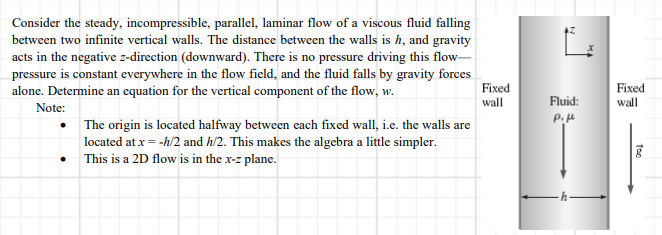Consider the steady, incompressible, parallel, laminar flow of a viscous fluid falling between two infinite vertical walls. The distance between the walls is h, and gravity acts in the negative z-direction (downward). There is no pressure driving this flow- pressure is constant everywhere in the flow field, and the fluid falls by gravity forces alone. Determine an equation for the vertical component of the flow, w. Fixed wall Fixed wall Fluid: Note: The origin is located halfway between each fixed wall, i.e. the walls are located at x= -h/2 and h/2. This makes the algebra a little simpler. This is a 2D flow is in the x-z plane.
Consider the steady, incompressible, parallel, laminar flow of a viscous fluid falling between two infinite vertical walls. The distance between the walls is h, and gravity acts in the negative z-direction (downward). There is no pressure driving this flow- pressure is constant everywhere in the flow field, and the fluid falls by gravity forces alone. Determine an equation for the vertical component of the flow, w. Fixed wall Fixed wall Fluid: Note: The origin is located halfway between each fixed wall, i.e. the walls are located at x= -h/2 and h/2. This makes the algebra a little simpler. This is a 2D flow is in the x-z plane.
Elements Of Electromagnetics
7th Edition
ISBN:9780190698614
Author:Sadiku, Matthew N. O.
Publisher:Sadiku, Matthew N. O.
ChapterMA: Math Assessment
Section: Chapter Questions
Problem 1.1MA
Related questions
Question
Yes it is hard questoin and that is all the data they give me

Transcribed Image Text:Consider the steady, incompressible, parallel, laminar flow of a viscous fluid falling
between two infinite vertical walls. The distance between the walls is h, and gravity
acts in the negative z-direction (downward). There is no pressure driving this flow-
pressure is constant everywhere in the flow field, and the fluid falls by gravity forces
alone. Determine an equation for the vertical component of the flow, w.
Fixed
wall
Fixed
wall
Fluid:
Note:
P.H
The origin is located halfway between each fixed wall, i.e. the walls are
located at x = -h/2 and h/2. This makes the algebra a little simpler.
This is a 2D flow is in the x-z plane.
Expert Solution
This question has been solved!
Explore an expertly crafted, step-by-step solution for a thorough understanding of key concepts.
This is a popular solution!
Trending now
This is a popular solution!
Step by step
Solved in 3 steps with 3 images

Knowledge Booster
Learn more about
Need a deep-dive on the concept behind this application? Look no further. Learn more about this topic, mechanical-engineering and related others by exploring similar questions and additional content below.Recommended textbooks for you

Elements Of Electromagnetics
Mechanical Engineering
ISBN:
9780190698614
Author:
Sadiku, Matthew N. O.
Publisher:
Oxford University Press

Mechanics of Materials (10th Edition)
Mechanical Engineering
ISBN:
9780134319650
Author:
Russell C. Hibbeler
Publisher:
PEARSON

Thermodynamics: An Engineering Approach
Mechanical Engineering
ISBN:
9781259822674
Author:
Yunus A. Cengel Dr., Michael A. Boles
Publisher:
McGraw-Hill Education

Elements Of Electromagnetics
Mechanical Engineering
ISBN:
9780190698614
Author:
Sadiku, Matthew N. O.
Publisher:
Oxford University Press

Mechanics of Materials (10th Edition)
Mechanical Engineering
ISBN:
9780134319650
Author:
Russell C. Hibbeler
Publisher:
PEARSON

Thermodynamics: An Engineering Approach
Mechanical Engineering
ISBN:
9781259822674
Author:
Yunus A. Cengel Dr., Michael A. Boles
Publisher:
McGraw-Hill Education

Control Systems Engineering
Mechanical Engineering
ISBN:
9781118170519
Author:
Norman S. Nise
Publisher:
WILEY

Mechanics of Materials (MindTap Course List)
Mechanical Engineering
ISBN:
9781337093347
Author:
Barry J. Goodno, James M. Gere
Publisher:
Cengage Learning

Engineering Mechanics: Statics
Mechanical Engineering
ISBN:
9781118807330
Author:
James L. Meriam, L. G. Kraige, J. N. Bolton
Publisher:
WILEY